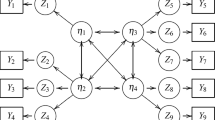Abstract
Many models to analyze incomplete data that allow the missingness to be non-random have been developed. Since such models necessarily rely on unverifiable assumptions, considerable research nowadays is devoted to assess the sensitivity of resulting inferences. A popular sensitivity route, next to local influence (Cook in J Roy Stat Soc Ser B 2:133–169, 1986; Jansen et al. in Biometrics 59:410–419, 2003) and so-called intervals of ignorance (Molenberghs et al. in Appl Stat 50:15–29, 2001), is based on contrasting more conventional selection models with members from the pattern-mixture model family. In the first family, the outcome of interest is modeled directly, while in the second family the natural parameter describes the measurement process, conditional on the missingness pattern. This implies that a direct comparison ought not to be done in terms of parameter estimates, but rather should pass by marginalizing the pattern-mixture model over the patterns. While this is relatively straightforward for linear models, the picture is less clear for the nevertheless important setting of categorical outcomes, since models ordinarily exhibit a certain amount of non-linearity. Following ideas laid out in Jansen and Molenberghs (Pattern-mixture models for categorical outcomes with non-monotone missingness. Submitted for publication, 2007), we offer ways to marginalize pattern-mixture-model-based parameter estimates, and supplement these with asymptotic variance formulas. The modeling context is provided by the multivariate Dale model. The performance of the method and its usefulness for sensitivity analysis is scrutinized using simulations.
Similar content being viewed by others
References
Cook RD (1986) Assessment of local influence. J Roy Stat Soc Ser B 2: 133–169
Glynn RJ, Laird NM, Rubin DB (1986) Selection modelling versus mixture modelling with non-ignorable non-response. In: Wainer H (eds) Drawing inferences from self selected samples. Springer, New York, pp 115–142
Hogan JW, Laird NM (1997) Mixture models for the join distribution of repeated measures and event times. Stat Med 16: 239–258
Jansen I, Molenberghs G (2007) Pattern-mixture models for categorical outcomes with non-monotone missingness. (Submitted for publication)
Jansen I, Molenberghs G, Aerts M, Thijs H, Van Steen K (2003) A Local influence approach applied to binary data from a psychiatric study. Biometrics 59: 410–419
Kenward MG, Molenberghs G, Thijs H (2003) Pattern-mixture models with proper time dependence. Biometrika 90: 53–71
Little RJA (1993) Pattern-mixture models for multivariate incomplete data. J Am Stat Assoc 88: 125–134
Little RJA (1994) A class of pattern-mixture models for normal incomplete data. Biometrika 81: 471–483
Little RJA (1995) Modeling the drop-out mechanism in repeated measures studies. J Am Stat Assoc 90: 1112–1121
Little RJA, Rubin DB (2002) Statistical analysis with missing data, 2nd edn. Wiley, New York
Michiels B, Molenberghs G, Bijnens L, Vangeneugden T, Thijs H (2002) Selection models and pattern-mixture models to analyze longitudinal quality of life data subject to dropout. Stat Med 21: 1023–1042
Michiels B, Molenberghs G, Lipsitz SR (1999a) A pattern-mixture odds ratio model for incomplete categorical data. Commun Stat Theory Methods 28: 2843–2869
Michiels B, Molenberghs G, Lipsitz SR (1999b) Selection models and pattern-mixture models for incomplete categorical data with covariates. Biometrics 55: 978–983
Molenberghs G, Kenward MG (2007) Missing data in clinical studies. Wiley, New York
Molenberghs G, Verbeke G (2005) Models for discrete longitudinal data. Springer, New York
Molenberghs G, Kenward MG, Goetghebeur E (2001) Sensitivity analysis for incomplete contingency tables: the Slovenian plebiscite case. Appl Stat 50: 15–29
Molenberghs G, Lesaffre E (1997) Marginal modelling of correlated ordinal data using a multivariate Plackett distribution. J Am Stat Assoc 89: 633–644
Molenberghs G, Michiels B, Kenward MG, Diggle PJ (1998) Monotone missing data and pattern-mixture models. Stat Neerl 52: 153–161
Park T, Lee SY (1999) Simple pattern-mixture models for longitudinal analysis with missing observations: analysis of urinary incontinence data. Stat Med 18: 2933–2941
Rubin DB (1976) Inference and missing data. Biometrika 63: 581–592
Rubin DB (1977) Formalizing subjective notions about eh effect of non-respondents in sample surveys. J Am Stat Assoc 72: 538–543
Rubin DB (1987) Multiple imputation for non-response in surveys. Wiley, New York
Thijs H, Molenberghs G, Michiels B, Verbeke G, Curran D (2002) Strategies to fit pattern-mixture models. Biostatistics 3: 245–265
Verbeke G, Lesaffre E, Spiessens B (2001) The practical use of different strategies to handle dropout in longitudinal studies. Drug Inf J 35: 419–434
Welsh AH (1996) Aspects of Statistical Inference. Wiley, New York
Wu MC, Carrol RJ (1988) Estimation and comparison of changes in the presence of informative right censoring by modelling the censoring process. Biometrics 44: 175–188
Wu MC, Bailey KR (1989) Estimation and comparison of changes in the presence of informative right censoring: conditional linear model. Biometrics 45: 939–955
Author information
Authors and Affiliations
Corresponding author
Rights and permissions
About this article
Cite this article
Sotto, C., Beunckens, C., Molenberghs, G. et al. Marginalizing pattern-mixture models for categorical data subject to monotone missingness. Metrika 69, 305–336 (2009). https://doi.org/10.1007/s00184-008-0219-y
Published:
Issue Date:
DOI: https://doi.org/10.1007/s00184-008-0219-y




